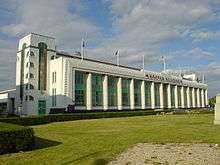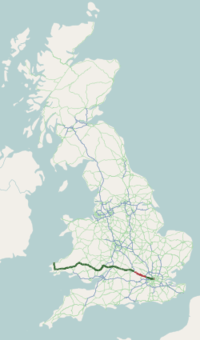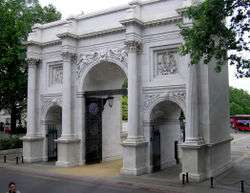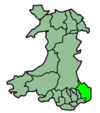A40 road
The A40 is a major trunk road connecting London to Goodwick (Fishguard), Wales, and officially called The London to Fishguard Trunk Road (A40) in all legal documents and Acts. It is 262 miles (422 km) long.
It is one of the few remaining of the "old" trunk routes not to have been superseded by a direct motorway link, though some parts, such as the southern section from London to Oxford are now better served by the M40. Part of the A40 forms a section of the unsigned Euroroute E30, which the former Welsh Assembly Government referred to as "one of the lowest standard sections of the Trans European Road Network in the United Kingdom"[1]
History
The original (1923) route of the A40 was the City of London to Fishguard. The road still begins and ends in the same places, but a number of changes have been made to its route.[2]
The first change dates from 1935, between Ross-on-Wye and Abergavenny. The original route of the A40 was via Skenfrith; this road was renumbered the B4521. The A40 was rerouted via Raglan; between Ross and Raglan it replaced part of the A48, between Raglan and Llanvihangel-nigh-Usk it replaced the B4234, and between Llanvihangel and Abergavenny it replaced part of the A471.
Subsequently, the A40 was rerouted within west London. Western Avenue dates from the 1930s, but was originally opened as the A403. After the Second World War, the A40 was rerouted along part of the A219 (west of Notting Hill) and Western Avenue. The old route (via Acton, Ealing, Southall, Hayes, Hillingdon and Uxbridge) was renumbered the A4020.
Route
Central London - Denham
For the A40 in London, see A40 road (London).
In central London it is named High Holborn, then Oxford Street. At Marble Arch it joins the A5 Edgware Road as far as the Marylebone Flyover to become Westway; formerly classified A40(M) as an elevated motorway, it has now been downgraded to 'A' road status. It takes the A40 to meet Western Avenue. With two exceptions, Western Avenue forms a grade-separated motorway standard dual-carriageway between Paddington (Westway) and the M40 motorway, which continues towards Oxford and Birmingham. The two at-grade intersections are Gypsy Corner and Savoy Circus; both of which are traffic light controlled. For the greater part, the road is six lanes wide, otherwise four lanes. At Denham Roundabout, the six lane Western Avenue flows into the M40.
Denham - Oxford
The A40 branches off Denham roundabout and runs alongside the M40 as a dual carriageway, concurrent with the A413. After the A413 branches off the A40 becomes single carriageway, still roughly following the route of the M40, passing through the towns of Beaconsfield and High Wycombe. Beyond Stokenchurch the road is much quieter; when meeting the B4009 and A329 those roads have priority. East of Oxford the A40 becomes a busy dual carriageway again, carrying traffic from the M40 to Oxford and beyond. The route forms the eastern section of the Oxford ring road (Oxford's bypass), crossing the A44 and A34 at the northern tip.
Oxford - Cheltenham (M5)
After the road passes under the A34, the A40 reverts to single carriageway for 10 miles (16 km). It then turns to dual carriageway again to form the Witney bypass, with a grade-separated junction. The dual carriageway then finishes at a roundabout. For the rest of Oxfordshire and Gloucestershire until Cheltenham, other than for a few short stretches, the road is single carriageway. This section has the highest point of the entire A40 which is 250 m (820 ft) above sea level, located 5 km west of the A429 junction. Before Andoversford the A436 breaks off to the west to try to take traffic away from descending into the centre of Cheltenham itself. The road travels through Cheltenham town centre along at least two parallel routes (neither is part of a one-way system: Sandford Road and Montpellier Terrace make up one part, Thirlestaine Road and Suffolk Road the other). Afterwards it becomes dual carriageway out of Cheltenham (past GCHQ) and has a junction with the M5 motorway. The junction is a three-level stacked roundabout, where neither road is interrupted.
Reopening the railway from Oxford to Witney
In February 2015, the Witney Oxford Transport Group proposed the reopening of Yarnton railway station as an alternative to improvements to the A40 road proposed by Oxfordshire County Council.[3]
There is a strong case to reopen the railway given the severe traffic congestion on the roads to and from Oxford to Witney railway station. [4]
Cheltenham (M5) - Abergavenny
The A40 then forms the Gloucester bypass, most of which is dual carriageway. The junction with the start of the A48 to Chepstow and South Wales is at Highnam. For the remainder of Gloucestershire, and a part of Herefordshire, the road is single carriageway until Ross-on-Wye. It then connects with the M50 motorway, and then forms part of the high quality dual carriageway between South Wales and the West Midlands. In Monmouthshire, the A40 has a grade separated junction with the A449, which continues as dual carriageway to Newport and the M4. The A40 travels west, still as dual carriageway, to Abergavenny.
Abergavenny - Carmarthen
Beyond Abergavenny, the road returns to single carriageway, running through the eastern part of the Brecon Beacons National Park until Brecon. The section between Abergavenny and Brecon has one of the highest points of the A40 which is 200 metres (660 ft) above sea level and is located at Bwlch, which is Welsh for 'pass'. The Brecon Bypass is a short, lightly trafficked dual carriageway which runs around the south of the town. At the end of the Brecon bypass the roads returns to a single carriageway and roughly follows the northern edge of the Brecon Beacons until Llandeilo. From here the A40 continues to Carmarthen where it then forms the eastern Carmarthen bypass as a dual carriageway, and meets up with the A48 at Pensarn. Driving time from Abergavenny to Carmarthen is between 60 and 90 minutes.
Carmarthen - Fishguard
At Carmarthen, the road "takes over" the main thoroughfare from the Motorway Network to Ireland from the A48 which ends at Carmarthen. Here, the A40 crosses the River Towy bridge by two 90-degree junctions, before continung to St Clears with 10 miles (16 km) of dual carriageway. After this, the road is a mixture of 2 and 3 lane single carriageway until it ends in Fishguard. This section of road is controlled by the Welsh Assembly Government, which describes it as "one of the lowest standard sections of the Trans European Road Network in the United Kingdom".[1] As a result, a number of improvements have been made or planned for this stretch.
St Clears to Haverfordwest dualling
There were plans in 2002 for a major improvement of the 23-mile stretch between St Clears and Haverfordwest which included upgrading to a dual carriageway. This was described as an extension to the M4 motorway network to the West Wales Coast, by virtue of it being a dual carriageway from the M4 motorway via the A48.[5] The £60 million scheme was subject to a European Environmental Assessment. Within a couple of years, the project appeared to be dying a very quiet death, causing local newspapers to report it being an election stunt for the two marginal constituencies that would best benefit from the improvements. The following Welsh elections saw both constituencies change the party of majority. The political party at the centre of the row instead directed the project deferment to damning environmental statements by Friends of the Earth Cymru.[6][7] The scheme was officially scrapped in 2008 after a Welsh Assembly committee decided to abandon the proposals. Instead, it recommended upgrades to the existing route including bypasses around Robeston Wathen and Llanddewi Velfrey using a three-lane option. This was welcomed by the Friends of the Earth, saying "The dual carriageway on the A40 would increase traffic levels, increase the emission of greenhouse gases, it would be harmful for the environment, it would be hugely expensive. That money would be better spent on improving public transport, on health, on education, there's no need for it. We think the assembly committee has come to the right decision".[8]
Whitland Bypass
The last improvement to the A40 on this section prior to the Welsh Assembly Government having the devolved responsibility for this road was a 4.1 kilometres (2.5 mi) £8 million bypass around Whitland. Constructed in 1994, the road started east of Black Bridge on the original A40, then running north of the town before rejoining the A40 at a new roundabout just west of Llain Cottage. The Secretary of State for Wales was asked a written question by Rhodri Morgan about adding a second carriageway to the Whitland bypass scheme, to which John Redwood replied "There are no proposals to add a second carriageway to the Whitland bypass. The design capacity of a single carriageway two-lane highway is more than adequate to cater with the anticipated traffic flows for the foreseeable future."[9]
Llanddewi Velfrey Bypass
A new bypass has been granted approval by the Welsh Assembly Government at Llanddewi Velfrey in Pembrokeshire. The scheme would improve the A40 between Llanddewi Velfrey and Penblewin, to the west of St Clears and meet the aim of the targeted investment in infrastructure along the east-west road corridor in south Wales.[10] From the east, it is proposed that a roundabout would be created just north of Glenfield Farm, where the straight section from St Clears ends at Bethel Chapel, and then take a new route north-west of the town of Llanddewi Velfrey, south-west over Pentroydin Fawr and Penttroydin Fech farms with cattle underpasses, a new underpass beneath the existing Llanddewi Velfrey to Llanfallteg road, before going over the original A40 at Ffynnon Wood. To the west of Ffynnon Wood, the road would then cross back over the original A40 to the east of Henllan Lodge in a way to maintain the tree lined avenue to Henllan, then run parallel to the A40 on the north side of the existing A40 to a new roundabount at Penblewin and the junction with the A478.[11]
This was originally known as the Blue and Purple routes during the Consultation in 2006[12] for which 75% preferred the blue route, and only 20% preferred the red route. 54% felt the section from Ffynnon Wood and Penblewin Roundabout needed improvement, with both orange and purple routes preferred by 42% of the respondents. Welsh Water/Dwr Cymru expressed concerns with the red route affecting water mains and sewers, and Henllanfallteg Community Council felt the red route would not improve the quality of life in Llanddewi Velfrey. Pembrokeshire County Council expressed concerns that the route planned was a single carriageway, and that within seven years, a dual carriageway would be required.
Robeston Wathen Bypass
A new bypass has been constructed between Penblewin and Slebech Park making the road straighter and with a '2+1' road layout to help improve overtaking opportunities.[13]
Starting to the west of Toch Lane (approx. 2 kilometres (1.2 mi) east of Slebech), the route travels eastwards for 4.6 kilometres (2.9 mi), passing 200 metres (660 ft) south of Robeston Wathen, and ending 0.5 kilometres (0.31 mi) east of the village, just west of Flimstone Lane.
Construction started on the route in February 2009, with the works completed and the new road opening 1 March 2011. The road was built by Costain. The scheme was nearly £14 million over the initial budget of £27.6 million, eventually costing £41.4 million. The Welsh Assembly Government explains this increase as being the result of inflation and land costs, saying the original budget did not include either, as well as additional statutory procedures, additional works following some design standards, and the increase in VAT.[14]
The Kell
The Kell is located on a section of the A40 that forms a north-south corridor between Fishguard, 17 kilometres (11 mi) to the north and Haverfordwest, 7.5 kilometres (4.7 mi) to the south, close to Treffgarne and Spittal. The improvement saw about 0.48 kilometres (0.30 mi) of new trunk road commencing at a point on the trunk road approximately 622 metres south of the centreline of the junction of the A40 trunk road with the C3059 road to Spittal and extending in a generally northerly direction to a point approximately 112 metres south of the junction of the trunk road with the C3059 road to Spittal.[15] This resulted in the road being rerouted through pasture to the east of the original road, taking a right hand bend about 160 metres (520 ft) south of The Old Mill, taking a 5.5% gradient, and rejoining the original road 210 metres (690 ft) north of The Kell. The original road has subsequently been converted to an access road for The Old Mill, Beavers Lodge and The Kell, accessing the new road at The Old Mill.
Fishguard Bypass
The Fishguard Bypass was planned to provide a more direct route with greater capacity to the Port of Fishguard at Goodwick avoiding the town centre of Fishguard. It was constructed during the late 1990s and opened in 2000. It takes the form of a three-lane carriageway on an approx. 10% gradient around the western edge of Fishguard. It runs from its highest point at Rafael roundabout 1 km south of Fishguard town in a generally northerly direction to its lowest point at Windy Hall roundabout where it rejoins the old A40 route at Gasworks Hill. The bypass is concurrent with a section of the A487 trunk road with the A40 dominant.[16][17]

Junctions: Abergavenny - M50
| A40 (T) | ||
| Eastbound exits | Junction | Westbound exits |
| The MIDLANDS Worcester (M50) Ross-on-Wye |
Roundabout | Ross-on-Wye The MIDLANDS Worcester (M50) |
| Hereford A49 Ross-on-Wye B4260 |
Wilton Roundabout | Ross-on-Wye B4260 Hereford A49 |
| Goodrich | Goodrich Junction | Goodrich |
| Hereford A4137 Goodrich B4229 |
Old Ross Road Junction | Hereford A4137 Goodrich B4229 |
| Whitchurch, Symond's Yat (West) | Whitchurch Junction | Whitchurch, Symond's Yat (West) |
| Exit only Whitchurch |
Whitchurch South Junction | No exit or access |
| No exit or access | Oak House Junction | Crocker's Ash, Doward |
| Monmouth A466 Chepstow (A466), Forest of Dean (A4136) A40 |
Old Dixon Roundabout | Monmouth A466 |
| Monmouth A466 | Wye Bridge Junction | Chepstow (A466), Forest of Dean (A4136) |
| Monmouth, Trelleck B4293 | Monnow Bridge Junction | Monmouth, Trelleck B4293 |
| No access or exit | Mitchel Troy Junction | Access only |
| Newport A449 | Raglan Interchange | Newport, Cardiff (M4) A449 |
| Abergavenny (A40), Raglan, Mitchel Troy | Raglan Junction | Raglan Mitchel Troy, Dingestow |
| Clytha Raglan Gwehelog |
Raglan Roundabout | Raglan Gwehelog Clytha |
| Hereford A465 Usk, Clytha B4598 |
Ysbytty Fields Roundabout | No access or exit |
| Newport A4042 Merthyr Tydfil A465 |
Newport A4042 Merthyr Tydfil A465 Hereford A465 | |
See also
| Wikimedia Commons has media related to A40 road (Great Britain). |
References
- 1 2 Welsh Assembly Government
- ↑ Road to Nowhere: A40 Ross-on-Wye to Abergavenny
- ↑ Elvery, Martin (2015-02-05). "Campaigners want new railway station at Yarnton to ease A40 congestion in West Oxfordshire". Witney Gazette. Retrieved 2015-02-12.
- ↑ http://www.oxfordshireguardian.co.uk/bid-to-reopen-train-track-ahead-of-key-rail-summit/
- ↑ "Dual carriageway for west Wales". BBC News. 2002-03-21.
- ↑ A40 dual carriageway safety claim challenged
- ↑ FOE Briefing
- ↑ "A40 dual carriageway plan blocked". BBC News. 2008-12-04.
- ↑ Hansard
- ↑ Welsh Assembly Government
- ↑ Llanddewi Velfrey Bypass Route (Welsh Assembly Government
- ↑ A40 Llanddewi Velfrey to Penblewin Public Consultation
- ↑ Welsh Assembly Government: Penblewin Improvements Archived 30 March 2012 at the Wayback Machine.
- ↑ "Over-budget Penblewin to Slebech Park bypass opens". BBC News. 2011-03-16.
- ↑ Statutory Instrument 3192 (2009)
- ↑ Fishguard Bypass Roundabout
- ↑ Rafael Roundabout
Further reading
- Edward Platt, Leadville: A Biography of the A40 (Picador, 2001). ISBN 0-330-39263-8.
Gallery
-

The Hoover Building, now a Tesco supermarket, is on the A40
-

The A40 at Monmouth
Coordinates: 51°52′42″N 2°01′51″W / 51.87824°N 2.03084°W











